
Brookville Historic District is a national historic district located at Brookville, Jefferson County, Pennsylvania. The district includes 263 contributing buildings in the central business district and surrounding residential areas of Brookville. The buildings date between about 1838 and 1930, and include notable examples of vernacular and high style Late Victorian style architecture. Notable buildings include the Judge Elijah Heath House (1836), Railroad House Hotel (1851), Blood Block (1875-1876), Marlin Opera House Block (1883-1884), McKnight Building, Northside School (1939), Methodist Episcopal Church, Holy Trinity Episcopal Church (1872), Jenks Foundry (1878), Brookville Y.M.C.A. (1915), Columbia Theater (1918-1919), Jefferson County Courthouse (1867), Brookville Borough Building, and U.S. Post Office. Located in the district and separately listed are the Brookville Presbyterian Church and Manse, Joseph E. Hall House, and Gray-Taylor House.
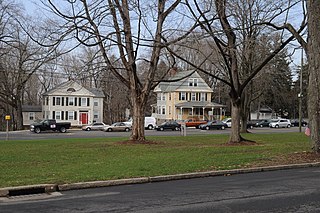
The Washington Street Historic District encompasses a residential area of Middletown, Connecticut that has a long history as a fashionable and desirable neighborhood. Extending along Washington Street and Washington Terrace between Main and Jackson Streets, the area has a broad diversity of residential architecture dating from 1752 to 1931, reflecting the city's patterns of growth. The district was listed on the National Register of Historic Places in 1985.
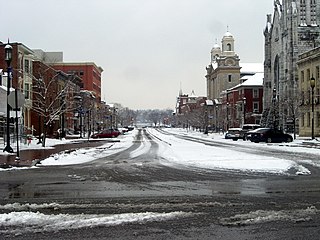
Harrisburg Historic District is a national historic district located at Harrisburg, Dauphin County, Pennsylvania. The district includes 340 contributing buildings and 1 contributing site in a 19th-century residential area of Harrisburg. It contains the original core of the city. Located in the district is Harris Park, which unifies the district. Notable buildings include the Y.M.C.A. (1932), William Maclay Mansion (1792), Grace Methodist Church (1871), St. Stephen's Episcopal Cathedral (1826), St. Michael's Lutheran Church (1906), Cathedral of Saint Patrick (1907) and the Unit Row Houses. The John Harris Mansion is located in the district and listed separately.

The Millionaire's Row Historic District is a national historic district located at Williamsport, Pennsylvania. The district includes 263 contributing buildings and one contributing site in a residential area of Williamsport. The buildings date as early as 1855, and are representative of Victorian style architecture. Notable non-residential buildings include the Trinity Church and Parish House, First Church of Christ-Scientist, Weightman Block, Park Home, and the Covenant Central Presbyterian Church. Way's Garden is the contributing site and it was established in 1913. Located in the district and separately listed is the Peter Herdic House.

Downtown Indiana Historic District is a national historic district located at Indiana in Indiana County, Pennsylvania. The district includes 86 contributing buildings and 1 contributing site in the central business district and surrounding residential areas of Indiana. The district includes notable examples of buildings in the Italianate, Second Empire, and Queen Anne styles. Notable buildings include the Federal-style William Houston House, Clawson Hotel, Thomas Sutton House, Calvary Presbyterian Church, Zion Lutheran Church, First United Presbyterian Church, and First Methodist Episcopal Church. The contributing site is Memorial Park, established as a burial ground in the early 19th century. Located in the district and listed separately are the Silas M. Clark House, James Mitchell House, Old Indiana County Courthouse, Indiana Borough 1912 Municipal Building, Indiana Armory, and Old Indiana County Jail and Sheriff's Office.

Westmont Historic District is a national historic district located at Westmont in Cambria County, Pennsylvania. The district includes 430 contributing buildings and 2 contributing sites in a predominantly residential area of eastern Westmont. The dwellings are in a variety of late-19th and early-20th-century architectural styles including Colonial Revival, Queen Anne, and Arts and Crafts styles. Notable buildings include the Charles Price House (1891), David Cohoe House, Love House (1912), John C. Ogden House, John Schonhardt House, Frank Buchanan House (1894), Harry S. Endsley House (1895), J. Leonard Replogle House, Elmer E. Stimmel House, F. J. Varner House, Our Mother of Sorrows Catholic Church (1924), and Westmont Presbyterian Church (1926). The contributing sites are The Mound and Indian Mound or Reservoir Park.

Stoystown Historic District is a national historic district located at Stoystown in Somerset County, Pennsylvania. The district includes 81 contributing buildings, two contributing sites, and one contributing object. It encompasses central business district and surrounding residential areas in Stoystown. They primarily date from the late-19th and early-20th century. Notable non-residential buildings include the Grace Lutheran Church (1888), St. Paul's United Church of Christ (1897), John Griffin Building, Laurel Bank (1922), former Custer House, H.J. Specht Hardware, former IOOF Hall, and former public school (1929). The contributing sites are the Union Cemetery and Stoystown-Quemahoning Township Area Recreation Park. The contributing object is a Lincoln Highway marker (1928). Located in the district and separately listed is the Hite House, dated to 1853.

East Berlin Historic District is a national historic district located at East Berlin in Adams County, Pennsylvania. The district includes 177 contributing buildings in the central business district and surrounding residential areas of East Berlin. They primarily date from the third quarter of the 18th to the early-20th century. It includes a notable collection of 18th century log and stone dwellings. Notable buildings include 426 W. King Street, 414 W. King Street, 412 W. King Street (1790), 400 W. King Street (1897), 210 W. King Street, 200–202 W. King Street, 110 W. King Street, 105–107 W. King Street, 127 W. King Street, 529 W. King Street, 115–117 E. King Street, 119–121 E. King Street, 104 Fourth Street, and Church School House.
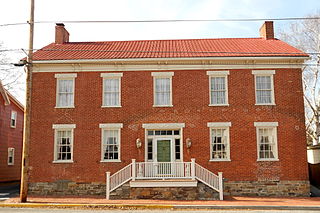
Fairfield Historic District is a national historic district located at Fairfield in Adams County, Pennsylvania. The district includes 117 contributing buildings, 1 contributing site, and 2 contributing structures. It encompasses the central business district and surrounding residential areas of Fairfield, including the Daniel Musselman Farm. They primarily date from the late-18th to the mid-19th century. It includes several homes used as hospitals following the July 3, 1863, 6th U.S. Cavalry skirmish during the Battle of Fairfield of the Gettysburg Campaign. The Musselman Farm property served as the field hospital for Johnson's Division of the Confederate States Army. Notable buildings include the John Miller Manor House (1797), Greek Revival architecture-style Musselman Farmhouse and stone / frame barn complex, Lutheran and Roman Catholic churches, Mrs. Blythe House, and R.C. Swope House. Located in the district is the separately listed Fairfield Inn.

Boiling Springs Historic District is a national historic district located at Boiling Springs, Cumberland County, Pennsylvania. The district includes 127 contributing buildings, 1 contributing site, and 1 contributing structure associated with its role as an early iron manufacturing center and surrounding residential areas of Boiling Springs. Most of the contributing buildings date to the mid-19th century starting in 1845, with a few dated to the early period of development. The oldest buildings are a grist mill, ironmaster's mansion (1795), and the restored Boiling Springs Tavern (1832). Other notable non-residential buildings include the former stone stables (1829) and forge building (1850s). Residential areas include notable examples of the Bungalow/craftsman, Late Victorian, and Federal styles. The contributing structure is a stone three-arched bridge (1854).

Carlisle Historic District is a national historic district located at Carlisle, Cumberland County, Pennsylvania. The district includes 1,011 contributing buildings, 1 contributing site, and 1 contributing object in the central business district and surrounding residential areas of Carlisle. Most of the contributing buildings date to the mid- to late-19th century, with a few dated to the 18th century. Residential areas include notable examples of the Late Victorian and Federal styles. Notable non-residential buildings include the Cumberland County Courthouse (1845-1846), St. John's Episcopal Church, Cumberland County Prison, First Lutheran Church, Tavern, First Presbyterian Church, Theatre, Fire House, Grace United Methodist Church, and St. Patrick's Church.

Mercersburg Historic District is a national historic district centered on the center square of Mercersburg in Franklin County, Pennsylvania. The district includes 124 contributing buildings and 1 contributing site in the central business district and surrounding residential areas of Mercersburg. The residential buildings include a number of sheathed log, stone, and brick dwellings, with some dating to the 18th century. The district has a number of notable examples of the Federal, Greek Revival, and Colonial Revival styles.

Catasauqua Residential Historic District is a national historic district located at Catasauqua, Lehigh County, Pennsylvania. The district includes 63 contributing buildings in Catasauqua. It consists mainly of large mid- to late-19th century dwellings in a variety of architectural styles including Colonial Revival, Queen Anne, and Neo-Classical Revival styles. Notable residences are the Dery Mansion, David Thomas House, Fatzinger House, and Oscar Stein House.
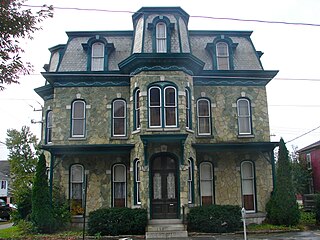
Danville Historic District is a national historic district located in Danville, Montour County, Pennsylvania. It encompasses 291 contributing buildings, 3 contributing sites, and 1 contributing object in the central business district and surrounding residential areas of Danville. The buildings mostly date from the 1840s to the early 20th century. The district incorporates the previously listed and predominantly residential Danville West Market Street Historic District. Residential buildings are mostly of brick and frame construction, with some log and stone dwellings, and in a variety of architectural styles including Italianate, Federal, Queen Anne and Second Empire. It includes the separately listed General William Montgomery House and Thomas Beaver Free Library and Danville YMCA. Other notable non-residential buildings include the Montour County Courthouse (1871), Mahoning Presbyterian Church (1853), Pine Street Lutheran Church, Eli Trego Building, Heim Suspender Factory (1835), First Ward School, Bnai Zion Temple, and Jemima Donaldson's Cross Keys Tavern.

Tamaqua Historic District is a national historic district located at Schuylkill Township and Tamaqua, Schuylkill County, Pennsylvania. The district includes 944 contributing buildings, 3 contributing sites, 8 contributing structures, and 3 contributing objects in the central business district and surrounding residential areas of Tamaqua. The residential buildings principally date to the early 20th century. They are mostly two-story, of brick and frame construction, and in a variety of popular architectural styles including Queen Anne, Late Victorian, Italianate, and Colonial Revival. Notable non-residential buildings include the Little Schuylkill Hotel (1827), White Swan, Washington House, Shepp Building, Elks Lodge, Peoples Trust Company Building, Tamaqua National Bank (1908), First National Bank of Tamaqua, U.S. Post Office (1932), Majestic Theater and Hotel, Hegarty Blacksmith Shop (1848), Conrad Biscoff Planing Mill and Furniture Factory (1865), Tamaqua Manufacturing Company (1910), Calvary Episcopal Church (1851), First Methodist Church (1852), St. Jerome's Roman Catholic Church (1856), American Hose Company (1881), East End Fire Co. (1923), and the former Tamaqua Armory. The contributing sites are St. Jerome's Cemetery, Odd Fellows Cemetery (1865), and the foundation of the Fitzpatrick Shirt Factory (1888). Contributing structures include three runs of iron steps and five bridges. Located in the district and separately listed are the Anthracite Bank Building, George Ormrod House, and Tamaqua Railroad Station.

Eagles Mere Historic District is a national historic district in the mountain lake resort of Eagles Mere in Shrewsbury Township, Sullivan County, Pennsylvania. The resort area was founded in the late nineteenth century and popular through the first half of the twentieth century. It surrounds Eagles Mere Lake.

Lewisburg Historic District is a national historic district located at Lewisburg, Union County, Pennsylvania. The district includes 853 contributing buildings, 2 contributing sites, 11 contributing structures, and 2 contributing objects in the central business district and surrounding residential areas of Lewisburg. Notable buildings include the Derr House (1773), 19th century and early-20th century Bucknell University buildings including Old Main and Bucknell Hall, Union County Courthouse (1856), U.S. Courthouse and Post Office (1933), Himmelreich Library (1902), First Presbyterian Church (1856), Christ Lutheran Church (1901), Union National Bank (1899), McClure Building (1913), Campus Theatre (1939), and the Buffalo Mills (1883). Also located in the district are the separately listed Chamberlin Iron Front Building, Packwood House-American Hotel, and Reading Railroad Freight Station. Contributing sites are the Lewisburg Cemetery and Soldiers Memorial Field. The contributing structures include five railroad bridges and the contributing objects are the Soldiers Memorial Monument (1901) and a commemorative plaque.
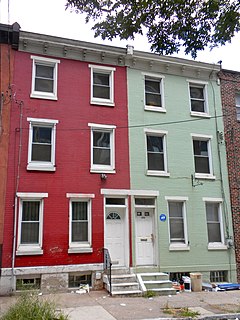
Girard Avenue Historic District is a national historic district located in the Cabot neighborhood of Philadelphia, Pennsylvania. It encompasses 137 contributing buildings. They were largely built in the mid- to late-19th century and consist of residential, commercial, and industrial properties. The residential buildings include blocks of 19th century speculative rowhouses. Residential buildings include notable examples of the Greek Revival, Late Victorian, and Beaux Arts styles. Notable non-residential buildings include the Church of the Gesú (1879), designed by Edwin Forrest Durang, and Northwestern National Bank (1886).

North East Historic District is a national historic district located at North East, Erie County, Pennsylvania. It includes 114 contributing buildings in the central business district and surrounding residential areas of North East. The district includes commercial, residential, institutional, and religious buildings. The buildings were built from the mid-19th to early-20th century and are in a variety of popular architectural styles including Greek Revival, Queen Anne, and Italianate. Located at the center of the district is Gibson Park. Notable non-residential buildings include commercial buildings along East and West Main Street and South Lake Street, the Concord Hotel, the Crescent Hose Company, Baptist Church, Presbyterian Church, and Methodist Church, two main buildings of St. Mary's Seminary, McCord Memorial Library (1916), and Heard Memorial School.

Coatesville Historic District is a national historic district located in Coatesville, Chester County, Pennsylvania. The district includes 457 contributing buildings in the central business district and surrounding residential areas of the city of Coatesville. The buildings date from the mid-18th century to 1937, with most built between 1850 and 1924. They are mostly two- and three-story commercial buildings constructed of brick. They include notable examples of the Gothic and Italianate styles. Notable buildings include the Fleming House, Brandywine Mansion, National Bank of Chester Valley (1917), St. Cecelia's Church (1870), Beth Israel Synagogue (1925), and Coatesville High School (1915). The district includes the separately listed Lukens Main Office Building, and "Terracina."
























